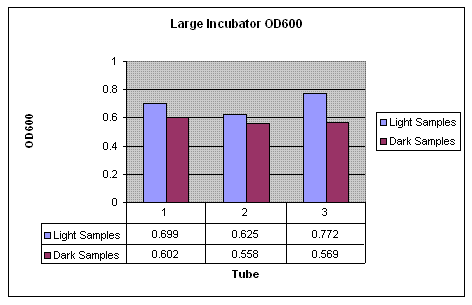Home
About ISB
Baliga
Group
High
School Interns
Halobacterium
Our Work
Making Cultures
Streaking Plates
Salinity Lab
Halo Growth with Incubator
Halo Growth without Incubator
Harvesting Membranes
Halo
Crystals
Microbiology
Skills Pt. 1
Microbiology
Skills Pt. 2
Our Mentors
 Institute for
Systems Biology
Institute for
Systems Biology
1441 North 34th Street
Seattle, WA 98103-8904
|
|
|
|
|
|
Aerobic Halo Growth with Incubator
Purpose:
To find and compare how well halo grows aerobically in light and dark
conditions. We will also look for differences between two shaker
incubators. This helps us find out if students can replicate the
data we find in a classroom situation.
Protocol:
We started with an OD600 of 0.816. Put 5ml of CM in 12 falcon
tubes. 6 of the tubes are rapped in electrical tape to block out
light. Added 1ml halo to all tubes. Put 3 dark and 3 light
in small shaker incubator under bench. Put 3 dark and 3 light in
large shaker incubator. Incubate for 48 hours at 220rpm and 37
degrees C. After 48 hours take OD of all samples, use 1ml cample
in cuvette, and blank with CM. Then take 1.6 ml and put in
eppendorf tube and spin in microcentrifuge for 15 minutes and use
pipette to remove supernatant. Take observations on size and
color of pellets.
Results:
The first time we tried the experiment the small incubator was accidentally turned off part way through the experiment so the results were inconclusive. The second time we tried the experiment we used the same protocol except we started with new halo at an OD600 of 0.820. We found that the light pellets in the large incubator were a little bit darker and noticeably larger than the dark pellets. In the small incubator the light samples are larger and more pink and the dark damples are smaller and more purple. The graph of the spectrophotometer data is below.


Conclusions:
The large incubator only had artificial light so the samples weren't
exposed to from each the full spectrum so the halo didn't flourish like in the
small incubator and the samples were pink as opposed to the purple in
the small incubator. However, the small incubator was set at a lower rpm
so less oxygen got to the sample so the OD600 was lower. Also,
the small incubator temperature was 32 degrees C, which is less than
the optimal temperature for halo growth. In addition, the small
incubator lights shine from the top onto the lids, and the lids dont
let in light as well because of their shape.
|
|
|
|
|
|
|